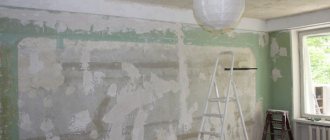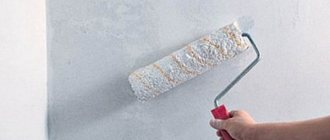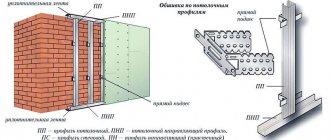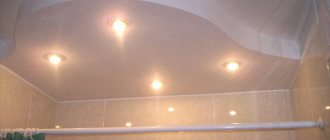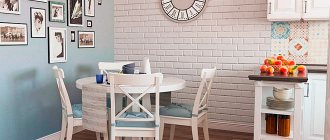The environmental situation of a big city, overpopulation and traffic congestion make many citizens think about moving to the countryside. Having decided to purchase a country house, a person must have a clear idea of what exactly he wants.
Will this be a cottage intended for permanent residence? Or a dacha on a garden plot, in which they plan to live only in warm weather? What infrastructure does the chosen location have? It depends on what is better: purchasing a house “turnkey” or “finishing out”.
How to prepare walls, ceiling, floor for final finishing.
So, you have finally become the happy owner of a brand new apartment in a new building.
When the first joy of the purchase has passed, it becomes clear that you will not be able to move into a new house any time soon. And all because the apartment is not suitable for habitation immediately after the completion of the house: brick walls, open shafts, hanging wires... If you are not going to completely trust the construction team with the repairs, and want to control everything, you will have to study and read a lot of articles, especially if This is your first renovation in your life. Apartment renovation in a new building includes several stages:
— preparation for final finishing: plastering walls, closing shafts, caulking cracks;
— finishing: preparing surfaces for decoration (plastering walls for wallpaper or painting), priming, preparing ceilings and door slopes;
— decoration: wallpapering walls, painting, laying laminate and tiles, arranging ceilings, installing doors, sockets, switches and lamps. Let's look at each point in detail, since each stage has its own nuances.
What does the term “turnkey” mean?
This is a fully ready-to-move-in cottage. Windows and doors, interior partitions have already been installed, the house is also landscaped from the inside: the floor is covered with laminate, linoleum or parquet, the walls are covered with wallpaper. And the bathroom and kitchen are equipped with everything you need...
The main feature for the buyer is that he can immediately move into such a house, without burdening himself with unnecessary worries about finishing and repairs.
What are the benefits of purchasing a home in turnkey condition?
- It is beneficial to purchase such a house if it becomes your only place to live. This is especially true if you have already sold your property in the city, and you should have the opportunity to immediately move to a new, fully finished country house;
- Buying a turnkey house is more profitable if you do not plan to invest further in its improvement, or do not have extra time until all repair and finishing work is completed. This option is also suitable for those who do not want to pay for expensive repairs and do not have the experience of doing it themselves;
- Quite often, cottages at this stage of readiness are purchased for the purpose of investing money, for subsequent rental or resale. At the same time, the owner is interested in ensuring that his purchase begins to pay off as quickly as possible.
Advantages and disadvantages of a clean apartment
When purchasing apartments with a fine finish, you can take advantage of the following advantages:
- You can immediately move into your home - all sockets, switches and plumbing fixtures are already connected and working, the rooms look comfortable, all that remains is to bring in and arrange the furniture;
- This apartment renovation is carried out in all rooms, so you won’t have to think about cosmetic restorations for a few more years.
And, like any item, fine finishing has its drawbacks:
- An apartment with a fine finish is not subject to major changes. Even if you need to change something to suit your taste, you will have to spend significant money and effort on this than if the alteration was carried out during roughing or pre-finishing;
- If during the construction of a house or renovation of an apartment some defects and violations of technology were made, then it will be more difficult to detect them if the finishing has already been done;
- Such apartments are more expensive and repairs are questionable.
Finishing an apartment consists of two steps:
1. The company that will create the interior often offers designer services. The client expresses his wishes, and the designer combines them with building rules and regulations. Finishing materials are discussed, then the turnkey project is presented in visual form on a computer screen, in 3D.
2. The second step is to competently draw up an estimate. It includes all services, consumables, their quantity and price. A work schedule is attached as an appendix to the estimate. A separate estimate is drawn up for each room.
Having understood the concept of “turnkey” (what it means for apartments), you can move on to other types of buildings being built using this term.
What is included in the Polis Group pre-finishing?
Pre-finishing includes the following types of work:
- installation of an entrance door, double-glazed windows with window sills and slopes;
- installation of a heating system with radiators;
- laying electrical wiring, water pipes, sewerage to connection points;
- arrangement of door and window slopes, plastering and puttying of walls, concrete floor screed.
As part of the pre-finishing, electricity, hot and cold water meters are also connected - the devices are included in the price of the apartment.
Despite the lack of official standards for apartment finishing, real estate specialists have a clear understanding of its varieties. Experts distinguish at least three types of finishes:
Rough finish
Rough finishing involves preparing the premises for finishing work. Although there is no legal definition of “rough finishing”, experts usually include the following components in this concept:
- floor screed - performed using cement-sand or self-leveling mixture;
- “rough” plastering work - involves leveling the vertical surfaces of the room using cement or lime mortar;
- installation of window blocks - as a rule, metal-plastic windows are installed in the premises; loggias can be glazed;
- installation of communications - usually the pipes of the heating supply systems are connected to the apartment, radiators are installed, the gas system, water supply and sewerage are installed. It is not a fact that the pipes were laid inside the apartment itself;
- installation of a gas stove - the presence of the stove itself in the kitchen does not mean that it was connected to the gas supply system;
- installation of power supply networks - electrical networks are installed in the apartment, there is an electrical panel with a meter, from which wires are laid to all switches, sockets and chandeliers. The wires are taken out of the wall, insulated, but not connected to energy consumption devices.
Expert advice
Sergey Petrov, executive director of the Academy of Sciences "Address"
Those types of finishes specified by the developer are conditional. There are no state standards, so we can only talk about the completeness of the mandatory work performed. Let me give you an example of a house where I saw such finishing: on the one hand, there is no plastering work at all, but there is a self-leveling floor. I would call it “partial rough finishing”, because what is it? This is the implementation of basic dirty work associated with large volumes of mixtures. If we are talking about “pre-finishing”, this means we are already working with finishing materials, as a result of which the apartment acquires light colors.
How to accept an apartment
When the house is already ready, and the owner receives the coveted invitation to the reception, he may not be ready for it. After all, the procedure requires searching for possible violations and shortcomings that arose due to the fault of the developer. The latter is obliged to eliminate the consequences of errors made during construction and installation.
Therefore, before putting your signature on the acceptance certificate, carefully check the apartment - then you will have to eliminate the result of unscrupulous work on your own.
We invite a specialist
An experienced eye immediately sees the catch, because he knows where to look and how it should be.
Professionals offer their services to inspect a new apartment. Where a beginner would spend half a day, a specialist can do it in an hour. And most importantly, he will indicate which violations are critical and which ones can simply be “turned a blind eye.” In addition, an outsider has a better chance of seeing flaws than an owner who is in a hurry to take ownership.
True, you will have to pay for the work of a specialist, but often this is a justified expense.
We check it ourselves
Inspecting your future home with a master's eye, and having in your head a rough plan for further arrangement, is a good thing. However, you need to arm yourself with a measuring tool that will make checking easier, and you also need to know what to look for.
For acceptance of an apartment with pre-finishing, the following will be useful:
Roulette
Choose a device with a length of at least 5 meters, and if the apartment is large, then 10 m.
Construction bubble level
It must be at least 1 m long. Also a good option would be a rule with a built-in level 2 - 2.5 m long. With its help it is convenient to check the curvature of surfaces.
Plumb
A string with a weight at the end is for checking vertical lines and planes.
Laser tools
Modern means that can replace almost everything else. A laser rangefinder is used instead of a tape measure, and a laser level will help you “shoot” all angles and planes. True, it is expensive, so it makes sense to rent it for more than a day.
Matchbox
To check air draft.
Construction square
For checking right angles in rooms, as well as window and door openings.
Multimeter (volt-ampere meter)
To check the voltage in the network.
Main stages of verification:
Entrance door
Check the geometric dimensions of the opening by applying a square. However, the misalignment can also be determined by indirect data, if the blade sticks and closes with a creak. Try leaving the door half open. If it opens completely on its own or, conversely, tends to slam shut, then the box is piled inward or outward during installation.
Pay special attention to the operation of the lock and latch. They should work easily, with sliding movements and clear clicks, the key should be easily inserted and removed from the keyhole.
Balcony
We continue to check the periphery. If the balcony is not glazed, then a visual inspection is sufficient.
In this configuration, there must be a drain for water - usually a narrow slot in the concrete at floor level or a pipe leading to the street.
Windows and window-balcony block
We visually inspect all the windows one by one. If slopes are made, then you will not be able to determine anything else by looking, if they are not there, make sure that a special insulating tape was used during installation (it is black or white, placed around the perimeter between the opening and the layer of foam).
After a visual inspection, light a match and draw it along the perimeter of the junction of the valves. The flame should not deviate anywhere. If in doubt, open the window and place a piece of paper in the problem area. After that, close the window and try to pull it out. If the paper comes out without effort, then there is a gap there.
Open the sash, shake it, you want it to avoid squeaking. Inspect the metal fittings on the frame and the frame itself - there should be no abrasions on it from the sash. The handles should close with gradually increasing force, the movement should be smooth, the handle should reach the end.
Wiring
If there are electrical cables laid in the apartment, then you should also check them. In modern construction, groups of electricity consumers are connected through several automatic toggle switches in the electrical panel at the entrance to the apartment.
It is better to carry out further checks together:
Touch the multimeter probes to the wire terminals in all socket boxes. On command, the second person turns on the toggle switch to supply current, and then turns it off again.
Armed with a stepladder, you can check the lighting and switches. Having bridged the terminals of the future switch, you need to touch the wires in the ceiling with the probes, at which time the second person on command turns on the toggle switch.
Important! Be careful when checking like this! Electric shock can be hazardous to health!
Heating and plumbing
If the apartment has heating radiators, during the cold season you can open the valves at the entrance to the apartment, and in half an hour you can understand how warm the rooms have become.
In the summer, at the end of spring and beginning of autumn, it is not possible to check the operation of the heating; you will have to trust the developer and wait for the cold season.
As for the plumbing, there are also nuances here. Some developers do not equip the pipe supply with shut-off valves, placing only plugs on the ends. In this case, the water will have to be turned off at the entrance to the apartment. If the ball valves are located on the pipe itself, just screw the flexible hose fitting into them and open the valve slightly, placing a bucket.
Ventilation
The exit of ventilation shafts must be present in two rooms - in the kitchen and in the bathroom. Therefore, these rooms are often adjacent.
Checking the draft of the ventilation duct is simple: you need to open the window slightly and bring a lit match to the window of the ventilation duct. The flame should deflect into the channel opening.
Floors and walls
Checking these parameters takes up the bulk of the apartment acceptance time. You need to go through all the rooms sequentially.
Horizontal surfaces are checked as follows: turn on the laser level and measure the distance from the resulting mark with a tape measure. If the indicator is the same in all corners of the room, then the floor is level.
A plastered wall is checked as follows: the rule is placed at a slightly angle to the plane, and a light source is placed on the other side. If the wall is uneven, with bumps or dips, this will be visible: light will break through the cracks between the rule and the wall.
An apartment with a fine finish - what is included in this concept
This concept, used in the construction industry, implies a full range of all internal work related to the renovation of the premises, after which it can be used for its intended purpose:
- as housing;
- as an office;
- as a trading floor, etc.
The scope of work assumes that in addition to finishing the walls, the following will be installed in the room:
- all communications;
- plumbers;
- electrical equipment, including sockets and switches;
- gas equipment;
- interior doors made of wood or fiberboard;
- reliable metal entrance doors, etc.
One of the finishing options
The cost of finishing is calculated per square meter and, understandably, it is quite expensive. Prices depend on the type of housing, its location and other factors.
Rules and procedure for repair and finishing work
After the apartment has been checked, you can think about renovations.
Advice! Be sure to draw up a project and estimate. Let it be a hand-made document in Excel and a 3D model in a free editor, but this is a mandatory step. Without it, there will be no complete picture of the upcoming work and cost control.
Once you have decided on the furnishings of all the rooms, you can get down to business.
The order of work is given taking into account that more “dirty” work does not spoil the already completed areas:
- Laying air conditioner routes, installing missing sockets and other electrical wiring lines, laying low-current systems if they are not installed.
At the same stage, slopes are constructed and the front door is reinstalled, if necessary. The junction areas of the slopes are insulated and plastered. - Tiling works. Ceramic tiles or porcelain stoneware are usually used to decorate the bathroom and toilet, a little less often the kitchen (apron and floor in the cooking area), as well as the hallway at the entrance to the apartment. All seams must be sealed and joints must be treated with plumbing sealant.
- Ceilings are being installed. Typically these are designs that allow you to hide the wires and at the same time provide a flat surface. These can be suspended or suspended (plasterboard) ceilings followed by painting.
- Final finishing of walls using interior paint, wallpaper or other means. In some cases, preliminary leveling with a thin layer of white putty may be required.
- Laying the final flooring – linoleum, laminate, parquet, quartz vinyl or other options. After the floors are done, it's time for the baseboards.
- Installation of interior doors. Due to the fact that the wallpaper has already been glued, its edges will be covered by the door frames. After installing the doors, the plinths are cut to size, and their ends are closed with decorative caps.
- Placement of lighting fixtures – chandeliers, lamps, sconces, lamps. Covers are put on all sockets and switches are installed.
- Installation of plumbing. Bathroom, toilet, sink - everything remains clean and intact thanks to what is placed at the end.
Note. Even with pre-finishing, the repair will take a lot of time. During this period, it is recommended to install a temporary toilet - your old one or purchased through the website or “live” at a flea market. This will make life easier for you (if you are doing the repairs yourself) or for the team.
After all the checks and repairs have been completed, the owners only have to bring in the furniture, and they can enjoy the comfort of their apartment.
What do they focus on during acceptance?
Usually the developer provides a guarantee for the finishing work performed. Therefore, before signing the acceptance certificate, it is important to ensure that all identified deficiencies are eliminated. What to focus on:
- If you are installing laminate flooring, check that there is a gap between the wall and the covering. Lateral loads can provoke further deformation of the plane.
- Linoleum in an apartment with a fine finish should be laid evenly, without bubbles or swelling.
- The maximum allowable size of differences in the ceiling is 3 mm.
- A plumb line or level is used to check the vertical and horizontal plane of the walls of a new building.
- When wallpapering, make sure that the joints are even and that there are no air bubbles.
- When tiling, the surface is tapped to identify voids. A ringing sound indicates their presence, which is unacceptable when performing fine finishing.
- High-quality door fastening implies the absence of creaking and a static position without mechanical impact. Doors in the apartment should not open or close on their own. When inspecting the entrance structure, pay attention to the degree of tension of the hinges and the seal.
- Checking the quality of finishing in a new building also applies to windows: frames and glass must be free of defects. The following evaluation criteria are smooth rotation of the handles, absence of drafts and fastening strength.
- The appropriate power of the electrical wiring is controlled by simultaneously turning on several electrical appliances. The required indicator is the absence of interruptions.
- Proper installation of plumbing fixtures during the final finishing of an apartment implies high-quality sealing of sewer tees, stability of the toilet and sink.
Time. When time really costs money
The issue of time worries real estate buyers not least. Finishing work cannot be completed in less than three months; on average, finishing can take up to six months; here you can add the postponement of deadlines by a couple of months, which has become a good tradition and norm for domestic developers.
Most apartments are purchased with a mortgage, finishing work takes a certain time, and until the property is registered (and the lien is registered in favor of the bank), the loan has to be paid at a higher interest rate.
In addition, while waiting for the completion of all work, for those who do not have their own apartment (and these are the majority)
you will have to continue paying for rented housing. But the investment attractiveness of an apartment with a turnkey finish is higher - immediately after registration, you can immediately let tenants in and receive your rent.
On the other hand, finishing it yourself will also take time, and significant time savings cannot be achieved. Even with ideal repair organization (purchase, delivery, work execution)
finishing will not be possible quickly. There are a number of technological processes that require drying of solutions - putty, plaster, self-leveling floors, tile adhesive, paint and varnish coatings. In addition, during the renovation you still need to live somewhere, that is, not everyone will be able to avoid the costs associated with paying for rented housing.
